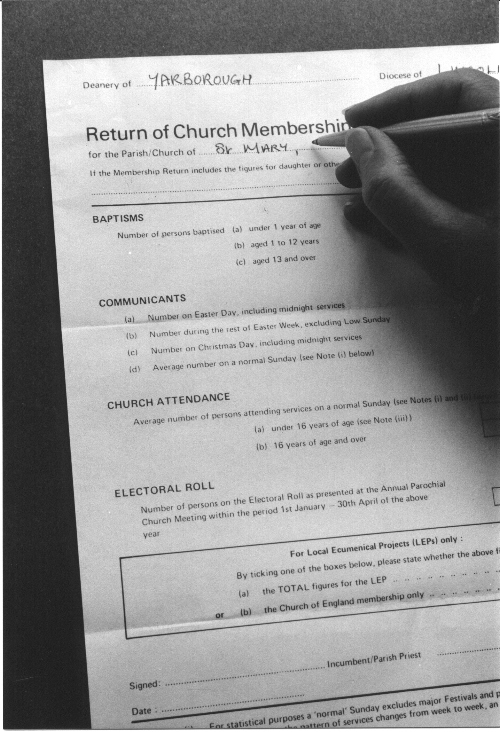 Church
of England clergy complete forms like these every two years or so. For most it
is an unwelcome chore. But the facts are important, even though people might
disagree about what lessons should be learned!
Church
of England clergy complete forms like these every two years or so. For most it
is an unwelcome chore. But the facts are important, even though people might
disagree about what lessons should be learned!
1. A Question of Numbers
A parish church in a country town (population
6000) recently undertook a stock-taking exercise.
As part of the process they decided to send
quite a detailed questionnaire to everyone they could think of who had any
contact with their church.
Their first problem was compiling the list! It
took a long time, cross-checking all sorts of incomplete lists - the Church
Electoral Roll, members of church organisations, magazine subscribers, families
of recently baptised babies, Sunday School parents and so on. In the end they
amazed themselves by producing a list of over 600 names.
The questionnaire duly went out, and they were
equally amazed when, after a lot of dedicated visiting, they got back well over
300 completed questionnaire forms. The response had been so great that they
could barely cope with the task of collating and analysing the results.
The overall effect of the exercise had been
very encouraging and the repercussions of what they had learned about themselves
were clearly going to be felt for months if not years.
But this story has a sting in its
tail: 600 is
only 10% of the population. Only between 60 and 120 people are in that church
every Sunday— between 1 % and 2 % of the population.
Even if it is assumed that another 1000 or
more are associated with the other three churches in the town, this still leaves
more than 4000 people who, seemingly, are unknown to any of the local churches.
What, one wonders, do they for their part know
of the churches? What are the churches doing to help them get the right message?
These figures, of course, are in stark
contrast to the figures about people's ‘faith journey’ as quoted from the BBC
survey.
Figures from the British Social Attitudes
Survey, quoted in the UK Churches Handbook: Religious Trends 1998/9, shows
committed church participation as steady since 1983 at about 26% of those who
indicate some religious allegiance. There has been a slight percentage
decline in those who show some religious allegiance (from 76% to 72% of the
population) although the actual number has been virtually static since
1975 at 42.2 million.
Usual Sunday attendances figures have fallen
in recent years - but there are signs that this reflects at least in part a movement away from
weekly to somewhat less frequent but no less regular patterns of attendance at
public worship. (What these church people do midweek is not measured!)
‘Spiritual affirmation’ - belief in God
and a serious quest for depth of meaning in life - are still important for more
than half the population (The BBC research and the British Social Attitudes
research both bear this out).
But clearly we must recognise that only a
relatively tiny percentage of the population is willing to make the connection
between spiritual affirmations and church-going.
Some research now suggests up to 40% of the
population should best be regarded as 'de-churched'. They have deliberately
walked away from a previous association with local church life. Only a tiny
proportion might be persuaded to return. Meanwhile up to 50% ('non-church') now
know nothing of church or Christianity apart from what they learned at school.
The ‘Question of Numbers’ therefore has a
disconcerting twist to it: At what point on a person's spiritual journey should
we expect church-going to become significant? Is ‘getting people to church’
what we are really about? Can it be a serious measure of our success or
faithfulness?
Click here for Action
Step 1
Go to next page
